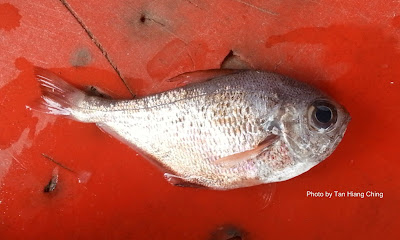Sweepers
Sweepers are the members of the Pempheridae family. They are small to medium sized fishes. Their body are compressed and deep. They have short dorsal fin in advance of anal fin, long anal fin base, and large eyes. They are found mainly in tropical and subtropical areas on coral reefs. During the day, they are often found in large schools and at night they disperse to feed on crustaceans and worms.
There are 2 genera and about 79 species worldwide. Malaysia is represented by at least 3 species.
There are 2 genera and about 79 species worldwide. Malaysia is represented by at least 3 species.
Scientific Name: Pempheris otaitensis Cuvier, 1831
English Name: Sweeper, Bullseye
Malay Name | Nama Melayu Malaysia: Ikan Sepat Laut
Thai Name | ชื่อสามัญภาษาไทย: ปลากระดี่ทะเล (Plā kradī̀ thale)
Main Identification Features: Body generally coppery. Prepelvic area narrow and keeled. Pectoral fins usually with dark base. Dorsal fin with dark leading edge, not expanded to produce dark tips on soft rays. Anal fin pale or lightly pigmented with a dark distal margin.
Size: Maximum standard length about 13 cm.
Habitat and Ecology: Coral and rocky reefs, to 15 m depth. Often found in large schools in caves or beneath ledges on reefs during the day. Disperse at night to feed on zooplankton, crustaceans and polychaete worms.

Scientific Name: Pempheris oualensis Cuvier, 1831
English Name: Blackspot Sweeper, Copper Sweeper, Oualan Bullseye
Malay Name | Nama Melayu Malaysia: Ikan Sepat Laut, Sepat Karang
Thai Name | ชื่อสามัญภาษาไทย: ปลากะดี่ทะเลหูดำ (Plā kadī̀ thale h̄ū dam)
Main Identification Features: Dark brown on back, shading to coppery on sides. Irregular vertical dark brown bars beneath rubbed–off scales. Dorsal fin broadly blackish along front margin and at tip. Anal fin pale, the basal part dusky, faintly black along margin. Caudal fin dark posteriorly. Pectoral fin base black.
Size: Maximum total length about 22 cm.
Habitat and Ecology: Coral and rocky reefs, 1 to 35 m depth. Often found in large schools in caves or beneath ledges on reefs during the day. Disperse at night to feed on benthic and planktonic crustaceans, other small invertebrates, and fishes at night.

English Name: Sweeper, Bullseye
Malay Name | Nama Melayu Malaysia: Ikan Sepat Laut
Thai Name | ชื่อสามัญภาษาไทย: ปลากระดี่ทะเล (Plā kradī̀ thale)
Main Identification Features: Body generally coppery. Prepelvic area narrow and keeled. Pectoral fins usually with dark base. Dorsal fin with dark leading edge, not expanded to produce dark tips on soft rays. Anal fin pale or lightly pigmented with a dark distal margin.
Size: Maximum standard length about 13 cm.
Habitat and Ecology: Coral and rocky reefs, to 15 m depth. Often found in large schools in caves or beneath ledges on reefs during the day. Disperse at night to feed on zooplankton, crustaceans and polychaete worms.

Scientific Name: Pempheris oualensis Cuvier, 1831
English Name: Blackspot Sweeper, Copper Sweeper, Oualan Bullseye
Malay Name | Nama Melayu Malaysia: Ikan Sepat Laut, Sepat Karang
Thai Name | ชื่อสามัญภาษาไทย: ปลากะดี่ทะเลหูดำ (Plā kadī̀ thale h̄ū dam)
Main Identification Features: Dark brown on back, shading to coppery on sides. Irregular vertical dark brown bars beneath rubbed–off scales. Dorsal fin broadly blackish along front margin and at tip. Anal fin pale, the basal part dusky, faintly black along margin. Caudal fin dark posteriorly. Pectoral fin base black.
Size: Maximum total length about 22 cm.
Habitat and Ecology: Coral and rocky reefs, 1 to 35 m depth. Often found in large schools in caves or beneath ledges on reefs during the day. Disperse at night to feed on benthic and planktonic crustaceans, other small invertebrates, and fishes at night.